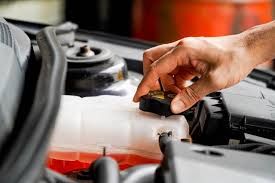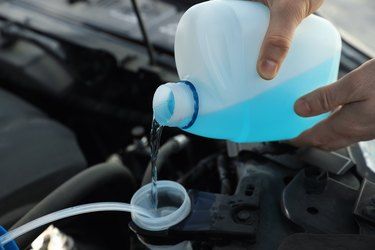


Automotive antifreeze is a vital fluid that regulates your vehicle's engine temperature. However, it's highly toxic and poses serious risks if spilled, especially to pets and children. This guide will walk you through the proper steps to clean up spilled antifreeze safely and effectively, protecting your loved ones and the environment.

Antifreeze's sweet taste and bright colors can attract pets and children, making accidental ingestion a significant concern. Prompt action is crucial to prevent potential poisoning and minimize exposure risks.
| Antifreeze Toxicity | Dangers to Pets and Children |
|---|---|
| Contains ethylene glycol or propylene glycol | Pets and children may ingest due to curiosity |
| Highly toxic if ingested or inhaled | Sweet taste and vibrant colors are enticing |
| Can cause kidney damage, neurological issues, and death | Accidental exposure can lead to life-threatening consequences |
Gather the necessary supplies and assess the spill's characteristics to ensure a safe and efficient cleanup process.
Absorbent materials (paper towels, kitty litter, baking soda)
Detergents (liquid laundry or dish soap)
Scrub brushes or brooms
Protective gear (gloves, goggles, mask)
Location (indoor or outdoor)
Quantity (amount spilled)
Surface type (porous or non-porous)
Ventilation (adequate airflow)
Act quickly to prevent the antifreeze from spreading further.
Use absorbent materials to soak up excess liquid
Allow absorbents to sit for 1-3 hours to fully absorb
Scoop up saturated absorbents and place in a sealed plastic bag
Dispose of contaminated materials according to hazardous waste regulations
Even after containing the spill, antifreeze can leave behind stubborn stains that require additional cleaning efforts.
Pour liquid laundry detergent or dish soap directly onto the stain
Detergent surfactants help break down the antifreeze
Use a stiff-bristled brush or broom
Apply firm pressure and use circular or back-and-forth motions
For set-in stains, let the detergent sit before scrubbing
Rinse the area thoroughly with clean water
Indoors, soak up rinse water with towels or a wet/dry vacuum
Outdoors, direct runoff away from storm drains or sensitive areas
| Step | Action |
|---|---|
| Repeat for stubborn stains | Apply detergent, scrub, and rinse until stain is removed |
| Dispose of contaminated materials | Place in sealed bag and follow hazardous waste regulations |
| Seek medical attention | If accidental ingestion or inhalation occurs |
| Contact emergency services | For large spills or situations beyond your capabilities |
Regularly inspect your vehicle's cooling system for leaks
Store antifreeze and automotive fluids securely, out of reach
Maintain proper antifreeze levels according to maintenance schedule
Keep a dedicated set of cleanup supplies readily available
Cleaning up spilled antifreeze requires prompt action, proper materials, and thorough techniques. By following this guide, you can effectively contain the spill, remove stains, and dispose of contaminated materials correctly, protecting your family, pets, and the environment. Remember to prioritize safety, seek medical attention if exposed, and take preventive measures to avoid future spills.
Antifreeze contains ethylene glycol or propylene glycol, which are highly toxic if ingested or inhaled. Exposure can cause kidney damage, neurological issues, and even death, especially in pets and children who may be attracted to its sweet taste and vibrant colors.
Gloves, goggles, and a mask or respirator should be worn to protect against skin contact, eye exposure, and inhalation of antifreeze vapors during the cleanup process.
Absorbent materials like paper towels, kitty litter, or baking soda should be used to soak up excess liquid antifreeze and prevent it from spreading further.
Apply liquid laundry detergent or dish soap directly onto the stain, scrub vigorously with a stiff brush or broom, and rinse thoroughly with clean water.
Contaminated materials, such as saturated absorbents and used PPE, should be placed in sealed plastic bags and disposed of according to hazardous waste regulations in your area.
Seek immediate medical attention if antifreeze is accidentally ingested or inhaled, as it can cause life-threatening consequences.
Regularly inspect your vehicle's cooling system for leaks, store antifreeze and automotive fluids securely, maintain proper antifreeze levels, and keep a dedicated set of cleanup supplies readily available.
For large spills or situations beyond your capabilities, contact emergency services for assistance in containing and cleaning up the spill safely.
No, antifreeze should never be poured down the drain or thrown in the trash due to its toxic nature. It must be disposed of according to hazardous waste regulations.
Porous surfaces like concrete or asphalt can be more difficult to clean, as antifreeze can seep into the material and leave stubborn stains. Repeated scrubbing and rinsing may be necessary.

Miguel started tinkering with car radios as a teenager, fascinated by the intricate dance of wires and circuits. This passion led him to pursue a career as an automotive electrician. For the past 10 years, Miguel has tackled everything from flickering headlights to mysterious electrical gremlins. He thrives on troubleshooting electrical problems and enjoys sharing his knowledge to empower car owners to understand their vehicles better.






